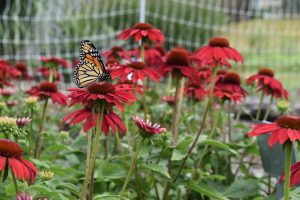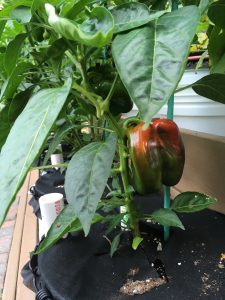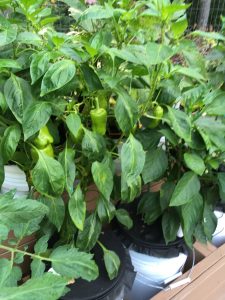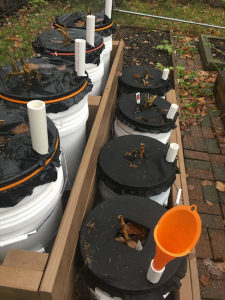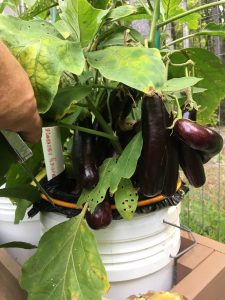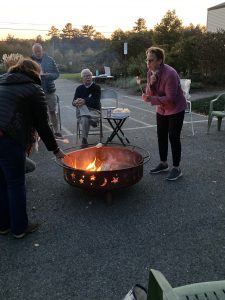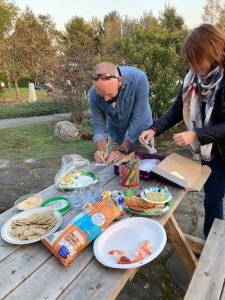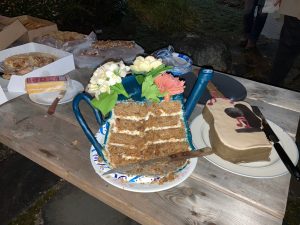Hancock and Washington Counties Master Gardener Volunteers News –December 2021
Table of Contents
Webinars offered | Statewide MGV Lunch & Learn | Self Irrigating Planters | MGV Celebration | Leadership in Action | Thank You MG Advisory| FEDCO ORDER | Song – Maine | Reporting Hours
Upcoming Dates to Remember
December 24: Christmas Holiday — Office Closed
December 31: New Years Holiday — Office Closed
January 3: Growing MicroGreens – Webinar
January 6: Bonsai Gardening – MGV Lunch and Learn Series
January 7- February 11: Tending Nature: Native Plants and Every Gardener’s Role in Fostering Biodiversity Webinars by BEE LAB
January 17: Martin Luther King Day – Office Closed
January 24: Hydroponics at Home – Webinar
January 19 and February 9: Adv MGV – Horticulture Therapy Training (watch for details)
February 3: The Problem with Peat – MGV Lunch and Learn Series
March 9, 16 and 23: Climate Change for Gardeners (watch for details)
COVID Protocols
We will keep you updated on any future Covid Safety protocol changes. Watch your emails. Thank you all for being so patient and cooperative!
Webinars Offered: Winter Gardening Series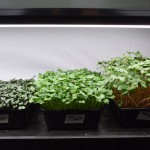
Growing MicroGreens
Monday, January 3, 6:00 – 7:15 PM
Register by January 3, HERE
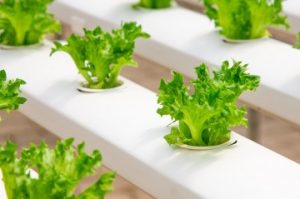
Hydroponics at Home
Register by 4 PM January 24, HERE
Statewide MGV Lunch and Learn Series – delivered by and for MGV’s
Beat the winter blues by tuning in for special monthly presentations by fellow Master Gardener Volunteers from across the state! This Statewide Lunch and Learn Series will take place on the first Thursday of each month at noon from December 2021 to April 2022.
No registration required!
Open only to Master Gardener Volunteers.
Please use the same Zoom information listed below for each webinar you attend:
Join from PC, Mac, Linux, iOS or Android: https://maine.zoom.us/j/82551078918?pwd=REVOenZwSWtxdkxOdlE2c3ZQL3FuUT09
Password: 093872 / Meeting ID: 825 5107 8918
Or Telephone: US: +1 301 715 8592
Upcoming Lunch and Learns
Bonsai Gardening
Thursday, January 6, 2022, Noon – 1 pm
Join Hancock County Master Gardener Volunteer (Class of 2019), Greg 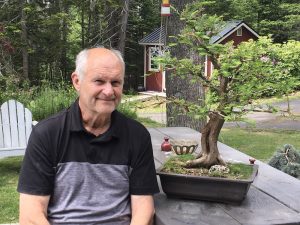 Mekras, as we explore the basics of bonsai gardening. We’ll briefly touch on the history of bonsai and learn techniques and tools to grow and shape a tree or shrub. Greg Mekras graduated Magna Cum Laude from Murray State University with a BS in Physics in 1982 accepting a job with Texas Instruments in Houston, TX. Retiring from TI 35 years, he later moved with his wife Valerie and daughter Victoria to Deer Isle, Maine to be near his wife’s large family. He became a Master Gardener Volunteer in 2019 and volunteers at Native Gardens in Blue Hill.
Mekras, as we explore the basics of bonsai gardening. We’ll briefly touch on the history of bonsai and learn techniques and tools to grow and shape a tree or shrub. Greg Mekras graduated Magna Cum Laude from Murray State University with a BS in Physics in 1982 accepting a job with Texas Instruments in Houston, TX. Retiring from TI 35 years, he later moved with his wife Valerie and daughter Victoria to Deer Isle, Maine to be near his wife’s large family. He became a Master Gardener Volunteer in 2019 and volunteers at Native Gardens in Blue Hill.
The Problem with Peat
Thursday, February 3, 2022, Noon – 1 pm
After several months of research, a committee of Cumberland County Master Gardener Volunteers will presentation on their findings on the environmental impact of harvesting peat moss and peat-free alternatives gardeners can use. They’ll also discuss other things gardeners can do to help eliminate their use of peat in the garden and encourage fellow MGVs to go peat-free! Committee members include Tom Witwicki, Bonnie Barthmaier, Barbara Dee, David Elliott, and Leigh Mundhenk.
Lunch and Learn Archives: Did you miss a past Lunch and Learn? – Find Recordings Here!
Additional Workshops and Opportunities
Advanced MGV Training Opportunities (Zoom) Sliding Scale Fee
Watch your e-mails for registration details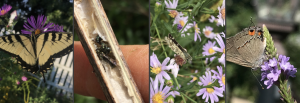
Horticulture Therapy Training (TBA)
January 19 and February 9, 2022. 12:00 – 1:15 PM
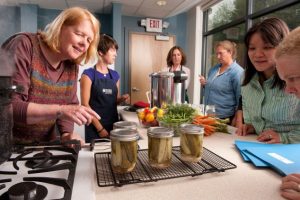
Climate Change for Gardeners (TBA)
March 9, 16 and 23, 2022, 12:00 – 1:15 PM
Cooking for Crowds (for MGV’s)
Dates TBD
Register Here
Self-Irrigating Planters (SIPs)
by Mel Tardie, MGV from the class of 2015
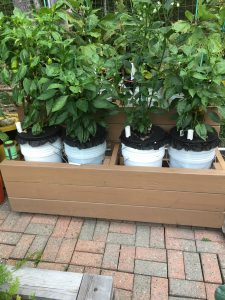
Three years into retirement, having completed the “honey-do list” around our home, my wife enrolled me in the University of Maine Extension Master Gardner program. Shortly after completion of the course, I became a Volunteer. Little did I realize how rewarding this experience would be! I’ve always enjoyed learning new things and what better program to take me on this new adventure that not only helped me with self-improvement, but has helped others in our community through the fruits of our labor, and has introduced me to some wonderful people in our community that I might not have had the pleasure of meeting.
I’m pleased to say I’ve volunteered many years at the Extension office with the greenhouse, vegetable/landscaping gardens, and the Volunteer garden at Woodlawn Museum. Along the way, I’ve learned so much from other great gardeners and helped others in our community. Isn’t this what retirement is supposed to be all about!
So with the thought of sharing my passion for learning new things, take a moment to read on about Self Irrigating Planters, or SIPs. We have been very impressed with this concept, and more importantly, the fantastic results we’ve had in using the SIPs in our home garden for the past 4-5 years.
Years ago, after a neighbor brought over some extra tomatoes and carrots from her garden, we were taken back by the difference in taste from our regular local grocery store tomatoes and carrots. It started us thinking about getting a vegetable garden going again since we were finally setting our roots down in southern Maine. After looking at our property we realized that no matter where we would like to place this garden, we had numerous challenges. Between the rocky ground and woody landscape, we decided that we needed to put in raised beds. We started with four 4ft X 8ft beds that we shared with the local wildlife and eventually grew to 9 fenced-in beds with 3 additional beds on the other side of the house. We always found that the tomatoes were difficult to grow due to the availability of sun and water when they needed it the most. After some research, we found an idea that was being used by urban gardeners and drought-prone developing countries. The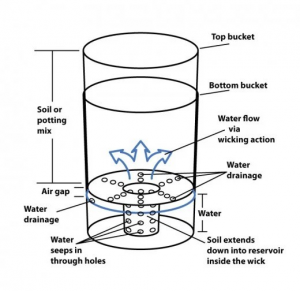 idea of having more control of our watering and sunlight seemed like a good deal for more productive plants and we thought, easily attainable.
idea of having more control of our watering and sunlight seemed like a good deal for more productive plants and we thought, easily attainable.
A self-irrigating planter (SIP) is a planter that allows water to be wicked up from a water storage reservoir as the plant needs it. While there are many different designs the following has worked extremely well as we pursue our desire for fresh vegetables. The traditional self-irrigating planter (SIP) uses two 5-gallon buckets. One bucket acts as a reservoir for the water, and the other holds potting mix along with the plant(s) of your choice. A smaller container holds the soil that allows the water from the reservoir to wick up to feed your plant(s) of choice.
The book Square Foot Gardening by Mel Bartholomew is a good guide for determining how much to plant in each bucket planter. This book gives suggestions based on the number of plants per square foot. Each 5-gallon bucket (12-inch diameter) ¾ of a square foot of garden space.
Items that you’ll need for your project:
- 2 five-gallon food grade buckets that can stack inside one another
- 1-inch plastic pipe or tubing (PVC works fine) about 6 inches longer than the height of one of your buckets.
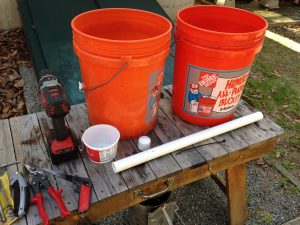
- A smaller plastic container (we like a 16oz cottage cheese container)
- A power drill with a ¼ inch drill bit
- Box cutter
- A piece of landscape fabric or black plastic large enough to cover the opening of one of your buckets
- Hacksaw to cut the PVC pipe
- String or bungee cord to hold the landscape fabric to the bucket
Turn the first (center) bucket upside down and mark the center. Around the center, draw a circle whose size is the diameter of the smaller plastic container. Using this circle as a guide, cut a hole in the bottom of the bucket that is just smaller than the diameter of your small plastic container. If you have a jigsaw, use this to cut the hole. If not, drill a series of small holes around the perimeter of the circle and use your box cutter to clean the hole. On the same bucket drill, roughly 25 – ¼ inch holes evenly spaced around the larger hole you just made.
Next, drill or cut a hole on the bottom of this bucket that corresponds to the diameter of your watering pipe or tubing. Make sure you cut a 45-degree angle piece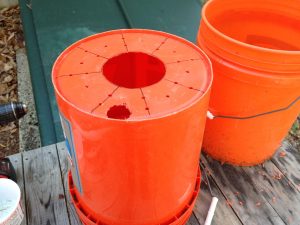 out of your watering pipe or tubing. This prevents the pipe or tube from clogging in your bucket.
out of your watering pipe or tubing. This prevents the pipe or tube from clogging in your bucket.
Use your drill and ¼” bit to make numerous holes on the sides of the small plastic container. NOTE: Do not cut through the bottom or lip of the small plastic container. These holes will allow the water from the water reservoir (exterior bucket) to wet the wicking material in the small container and travel up to the soil in the center bucket.
Then place the center bucket with the holes in it inside the exterior bucket and place the buckets in front of a light source so you can locate the bottom of the center bucket. Place a mark at that location and then drill two ¼” holes in the exterior bucket a quarter inch below this mark. These holes will act as overflow holes for your water reservoir.
With the buckets stacked together, place the plastic tube or PVC pipe with the angle end first through the hole you made in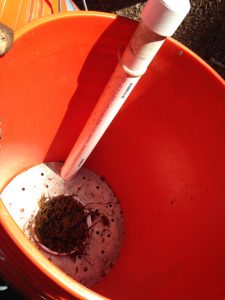 the center bucket. (At the top of the center bucket, we like to drill two holes on each side of the tube or pipe so that we can secure the top of the pipe with a wire tie to help hold the tube or pipe while filling the reservoir).
the center bucket. (At the top of the center bucket, we like to drill two holes on each side of the tube or pipe so that we can secure the top of the pipe with a wire tie to help hold the tube or pipe while filling the reservoir).
Pack the small plastic container with wet potting mix and set it inside the large hole in the center of the center bucket. Fill the center bucket 3/4” full of damp potting mix making it fairly compact. Plant your seedling and top off the bucket with potting mix.
Next, water your seedling from the top, for the first and only time to saturate the soil. After this initial watering, you only want to water your plant using the fill pipe. Take one cup of fertilizer and sprinkle it around the outside edge of your bucket leaving as large a space of plain soil in the middle as possible. Take your piece of landscape material or black plastic and make two slits in it, large enough to fit your seedling and watering tube through. Place the material over the top of the bucket while gently feeding the seedling and watering tube through the slits. Secure the material with a bungee cord or string.
When watering you’ll want to fill the reservoir until the water comes out of the overflow holes you made in the exterior bucket. This makes it impossible to overwater your plant. Every couple of days fill the reservoir till you have water come out of the overflow holes. You will notice that you may have to fill the reservoir more often as the weather warms and your plants start to flourish.
NOTE: It is very important that you NOT use standard garden soil in the SIP, because to function correctly the water must be wicked from the bottom to where the roots of the plant can soak up the moisture. Regular soil does not provide the capillary (wicking) action needed to move the moisture upward. Use potting soil with the main ingredient being sphagnum peat and/or coir.
Here are two recommended homemade recipes from “Global Buckets”:
- Recipe #1: Sphagnum Peat – 70% Sphagnum Peat, 20% Vermiculite, 10% Perlite
- Recipe #2: Sphagnum Peat & Coir – 35% Sphagnum Peat, 35% Coir, 20% Vermiculite, 10% Perlite
Resources:
- Green Roof Growers – How (and why) To Make SIP
- Mother Earth News – Build a Self-Watering Container
- University of Maryland Extension – Self-Watering Containers
- University of Illinois Extension – Self-Watering Containers
More Photos:
Master Gardener Volunteer Celebration!
Held at Hancock/Washington County University of Maine Cooperative Extension Office
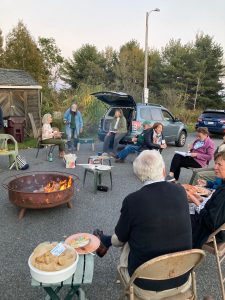
Festivities included roasting marshmallows around a fire pit which was generously donated by Linda Dunn and a spread of delicious food which included many fresh seasonal foods such as mulled apple cider, fresh salads, and fruit dishes, smoked and fresh turkey, and salmon. Appetizers and desserts were too numerous to remember. Cindy Blake shared two birthday cakes, decorated her Subaru with lights, and streamed Country music to set a festive mood. Seasoned Master Gardener Volunteers met some of our current class of Volunteers, sharing experiences and stories around the fire.
Thanks to the Celebration Committee for organizing this fun, safe way to be together. We tried to make the occasion as environmentally friendly as possible, having participants bring their own plates and utensils and having buckets for recyclables, compost, and trash. Committee Chairs were Jim Bradley, Betsy Armstrong, and Cindy Blake with help from Alison King, Sue Samuels, Katherine O’Dell, and Mary Doherty.
MGV Wendy Lessard receives the Leadership in Action Award!
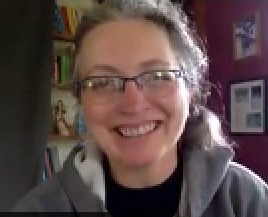
We are so proud of Wendy, who was selected by the Hancock County Extension Association Board to receive the 2021 Annette Valenoti Leadership in Action Award. This award was created in 2010 to honor a local citizen who has made a difference in the lives of people in Hancock County through their dedication to one or more of Cooperative Extension’s ideals. These ideals include:
- Promoting Healthy Living
- Raising Environmental Awareness
- Promoting Life-Long Learning, and
- Building Community
Wendy is a person who shines when she is doing community service. Prior to joining us as an Extension Master Gardener Volunteer, she spent nine years as an Ellsworth Public Library Trustee, three years on the State Board of American Massage Therapy Association, and two years volunteering as editor of the Journal of Maine Education.
Wendy was elected to the Master Gardener Volunteer Advisory Committee in 2019, just 2 months after she received her MGV certification. A year into her term, because of her terrific communication and obvious leadership skills, she was asked to serve as co-chair of this committee. She thoughtfully took on this role with dedication and focus, working in tandem with her fellow co-chair, MGV Mary Hartley. She and Mary just wrapped up their terms co-chairing, guiding, and streamlining the good work of this committee. They will both be deeply missed.
As a result of Wendy’s passion for caring for the environment and for promoting human wellness, we have conducted powerful educational outreach that has reached people across the state of Maine.
In spring of 2020, she played a lead role in organizing an all-day county-wide public event entitled Gear Up for Gardening, with multiple workshops led by expert speakers, only to be thwarted at the very last minute by the arrival of COVID and the mandatory state-wide stay safe at home order. Event canceled, though disappointed, she rallied to lead us in creating a successful online event the following fall; a panel discussion broadcast via Zoom on Gardening in a Shifting Climate with four guest speakers from around the state; a local organic farmer, an invasive plant biologist from Acadia National Park, and two Cooperative Extension specialists in water quality and Integrated Pest management.
management.
For two years, Wendy has created and organized a March Wellness Month for Master Gardener Volunteers, coordinating a series of workshops to help people prepare us for the gardening season, in topics like Garden Ergonomics, Practices for Stress Relief, Essentrics, Yoga, and Chi Gong for Gardeners. In 2020 the sessions were in person until again, COVID briefly shut us down, and in 2021, we went statewide, broadcasting these workshops over ZOOM, reaching 60 MGVs across the state.
In 2021 Wendy was instrumental in getting the monthly Hancock/Washington County MGV e-newsletter going. Thanks to a hard-working team of MGV Advisory Committee members, we’ve been able to publish eight monthly issues, streamlining our communications with you and better recognizing our volunteers and accomplishments! (newsletter committee: Wendy Lessard, Rita Buddemeyer, Holly Bixby, Jane Ham, Linda Dunn, Mary Doherty, Mary Hartley)
– Wendy has also served as a team leader/ organizer for our biennial Master Gardener Volunteer Plant Sale and Open House, which draws between 300 and 500 people.
Please join us in congratulating Wendy for her well-deserved award!
THANK YOU Retiring MGV Advisory Committee Members!
Did you know that we have an Advisory Committee that works closely with Marjorie to orchestrate and improve all aspects of the Hancock/Washington County MGV program? So much work happens behind the scenes to keep our program going, thanks to this committee of 15 dedicated individuals. Watch for the next issue of this newsletter for a description of what the MGVAC does, and think about whether YOU might be interested in a leadership role! Meanwhile, THANK YOU to the following dedicated individuals who have just ended their terms (3-4 yrs) on the MGVAC:
- Cindy Blake
- Rita Buddemeyer
- Mary Doherty
- Linda Dunn
- Mary Hartley
- Wendy Lessard
- Jessica Marks
We couldn’t have done it without you!
MGV Fedco Group Order Reminder!
We could save Up to 20% discount with our MGV Group Order. The deadline is January 12, and our Group Order # is 490023. And, if your order screen asks you for your credit card # you are not part of the group order.
(Original article from November)
Ordering Trees, Shrubs, & Perennials happening again this year! Great chance to add fruit, berries, and nuts to your landscape, or to work on pollinator support and re-wilding. Save up to 5, 10, 15, or 20%, depending on the size of the total order.
You must use Group Order #490023 to get the discount.
Our group name is Hancock Washington County Master Gardeners.
Here are your directions:
- Access their inventory at Fedco Seed’s website, Trees section. Or go to their “Trees” ordering page. Log in using your own email address.
- When you review your order prior to checking out, click the “Part of a Group” checkbox. Then go to “Checkout” and type in the group order number where indicated: 490023.
If you are prompted to enter a credit card number, stop. Back up. You did not choose “Part of a Group”. - You will receive a confirmation email at the address you used to log in. Until your coordinator finalizes the order, however, Fedco cannot confirm receipt of your order.
Our MGV deadline to get orders in is January 12. (You’ll see the 14 for Fedco, just setting local deadline a bit ahead in case there are any snags to smooth out as the coordinator).
Once the order is finalized, I’ll let you know our full discount. When the order ships, I’ll let you know your actual final amount due to me (they charge my credit card, you reimburse me), and directions to pick up. Pick up site is in Ellsworth.
Last year we were able to tap the 20% discount! Happy planning and dreaming.
Our Maine Winter Things
Lyrics by Rita, December 8, 2013. Sung to the tune of “My Favorite Things”
Fish huts in dooryards and blue tarps on store signs.
Plow blades on all trucks and woodpiles in long lines.
Sunsets at 4 that make darkness the king.
These are a few of our Maine winter things.
Cranes lifting boats out and guys hauling traps in.
Snow fences posted and driveways with sand bins.
Shops boarded shut and signed, “See you in spring.”
These are a few of our Maine winter things.
Reflectors lined up and wired high on rebar.
Folks loading ice mutts and roof rakes in their cars.
Storm Center music that prompts kids to sing.
These are a few of our Maine winter things.
When the cold bites,
When the sleet stings,
When I’m in gray clouds,
I simply remember it’s only for winter,
And then I laugh right out loud.
Shout out to all MGVs!
Know an MGV who’s done or is doing something intriguing or inspiring? Send in their name to MGVnewsletterinput@gmail.com; someone on the Newsletter team can follow up for a future newsletter spot. We know there are so many neat stories out there or MGVs finding ways to apply our training and experience.
Please be reminded to REPORT your Master Gardener Volunteer hours monthly
Volunteer Hours are due NOW – REPORT HERE
This month’s newsletter sent by Sue includes articles from our new “Communicate with MGV’s” task force. We’d like the next edition to feature your suggestions and articles about gardeners and gardens. Please contact us at MGVnewsletterinput@gmail.com with your ideas as we work on ways for us to stay in touch with all our gardening friends while following virus-safe guidelines.

